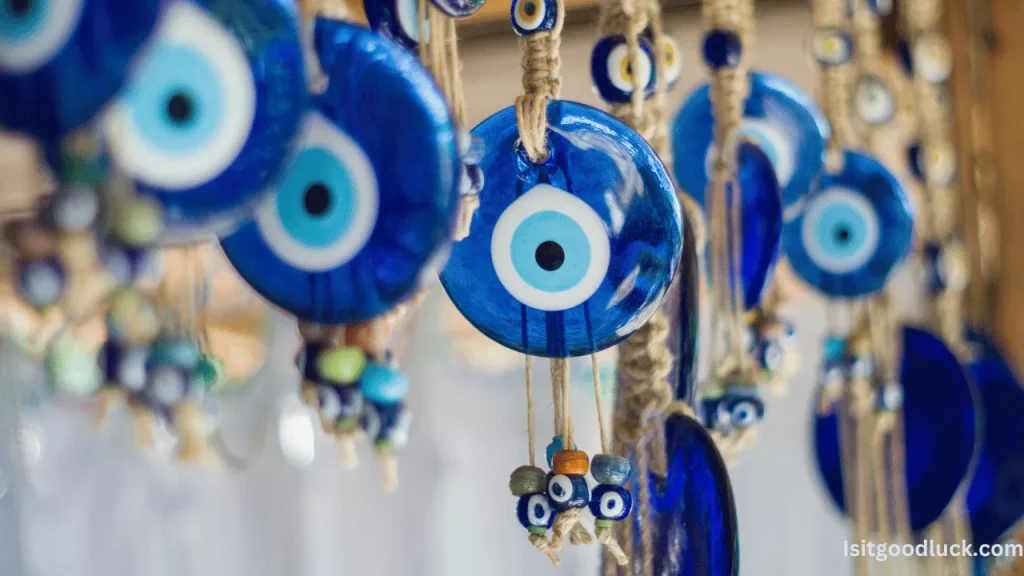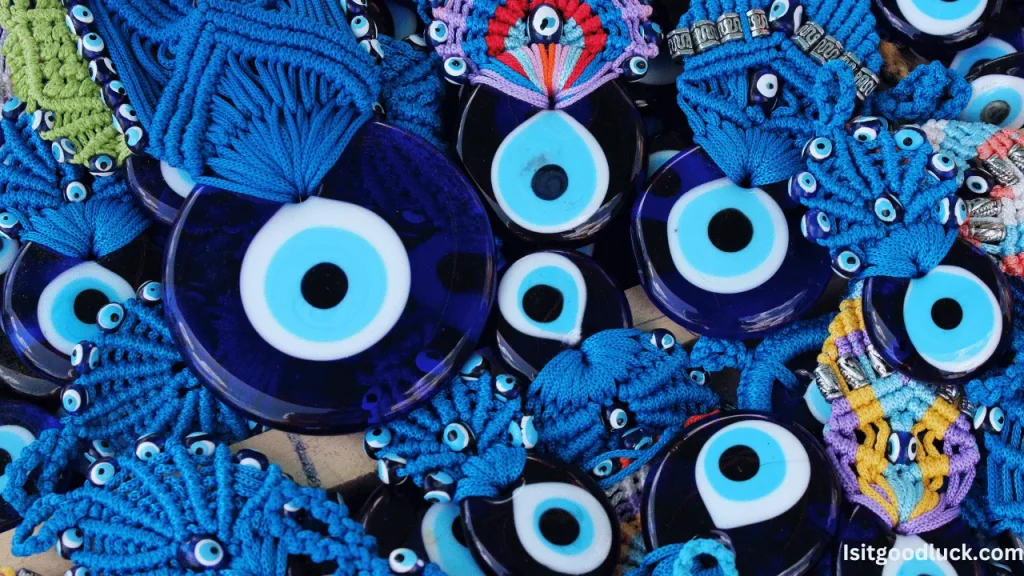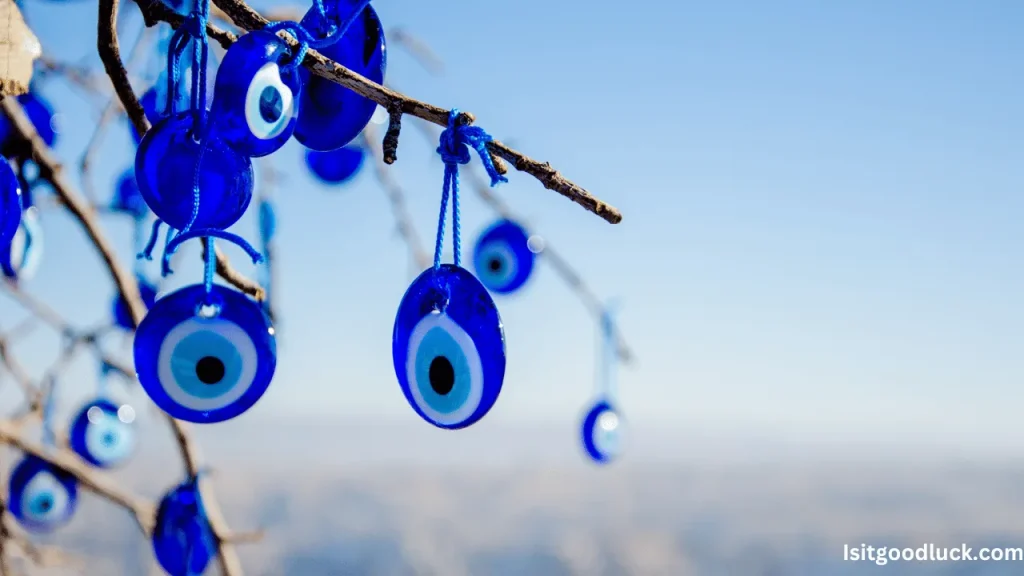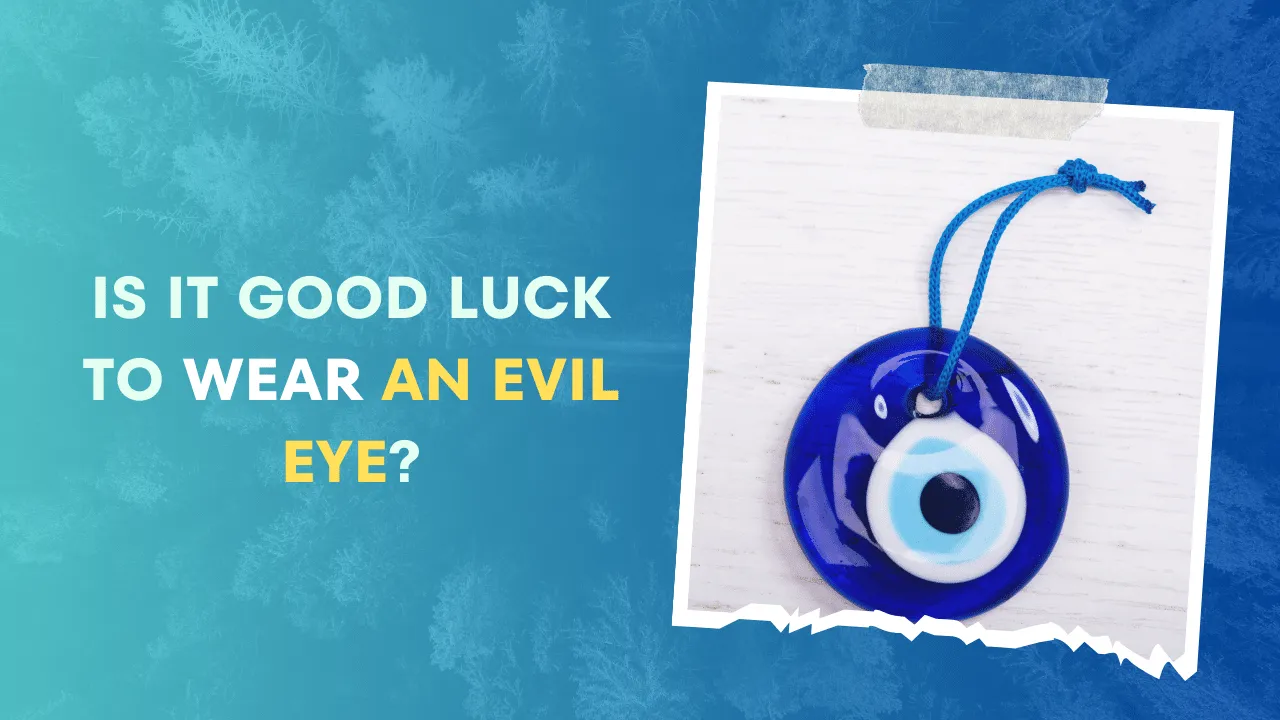You’ve heard the whispers, the rumors, and the ancient tales. The mysterious symbol, staring back at you from jewelry, tattoos, and even tucked away in the corner of some homes – the Evil Eye.
Yet, despite its somewhat ominous name, it is sought after by many, with believers in its powers spanning cultures and continents. But why?
Is there truth to the claim that it ushers in good fortune and wards off negative energy? Or is it simply a cultural superstition, an artifact of ancient times?
In this blog post, we’re not just unraveling threads of myth and superstition; we’re embarking on a journey to decipher centuries of belief systems and folklore, cutting across boundaries of space and time.
Whether you’re a skeptic looking for answers or a believer seeking affirmation, buckle up as we delve into the fascinating question: “Is it good luck to wear an evil eye?” Stay tuned as we uncover the hidden truths and widespread misconceptions, one blink at a time.
Contents [hide]
- 1 Historical Overview of the Evil Eye:
- 2 Is it Good Luck to Wear an Evil Eye?
- 3 The Science Behind the Evil Eye Superstition:
- 4 How Should I Wear the Evil Eye:
- 5 Conclusion
- 6 FAQs
- 6.1 Can anyone wear the Evil Eye, or is it specific to certain cultures or religions?
- 6.2 I’m not superstitious. Is there any point in me wearing the Evil Eye?
- 6.3 Is there a wrong way to wear or display the Evil Eye?
- 6.4 Can I gift the Evil Eye to someone?
- 6.5 How often should I replace my Evil Eye charm?
Historical Overview of the Evil Eye:
The story of the Evil Eye weaves a captivating narrative that stretches across the tapestry of human history, whispering tales of protection, power, and of course, good luck.
This enigmatic symbol has peered out from civilizations long past, anchoring itself deeply within the soil of our collective cultural consciousness.
Tracing its lineage, we find its first winks in the ancient civilizations of the Mediterranean and the Middle East, around 5000 years ago. The Sumerians of Mesopotamia, Egyptians, Greeks, and Romans knew of the Eye. But it wasn’t just an idle doodle in the margins of their society; it held a profound significance.
In these cultures, it was believed that envy or malice could cast a ‘curse,’ inflicting misfortune or injury upon the recipient. Here’s where our symbol comes into play. The Evil Eye was not the curse itself but rather a potent talisman, a shield against this malignant glare.
However, the association of the Evil Eye with good luck may feel a bit paradoxical, given its name. But it’s crucial to understand the role reversal the symbol has undergone.
It was conceived as a powerful protective symbol, a ‘mirror’ reflecting the curse onto the sender, hence the ‘evil’ in Evil Eye. Over time, this protective property evolved into a general symbol of good luck, a charm to ward off evil gazes and attract positivity and fortune.
From Pharaohs’ tombs to Greek pottery, from the bazaars of Istanbul to the chic fashion runways of Paris, the Evil Eye has journeyed through time, watching over humanity and whispering in its silent language tales of luck, protection, and enduring human belief.

Is it Good Luck to Wear an Evil Eye?
Embarking on the quest to decode the mystery of the Evil Eye, we find that each element holds its fascinating tale, contributing to the narrative of good fortune and protection. Like a silent language, the very design of this ubiquitous symbol speaks volumes about its centuries-old mission to guard and guide.
A vibrant, watchful pupil lies at the heart of the Evil Eye symbol. This is no ordinary ocular representation; it is the heart of the amulet, the mirror that reflects negativity away. It symbolizes vigilance, the ever-watchful divine gaze protecting you from unseen harm.
Surrounding this pupil, concentric circles or teardrop shapes of blue and white dance their protective waltz. The blue hue, often associated with the heavens, is believed to symbolize truth, tranquillity, and the spiritual plane. This heavenly blue is thought to ward off negative energy, mirroring back ill intentions and providing a soothing, protective aura to its wearer.
The color white is a symbol of purity, light, and goodness. It represents the cleansing and healing power of the divine, offering a blanket of purity to guard the soul from malice.
Also read: Is it Good luck to wear your birthstone?
As for the good luck part, the Evil Eye has been a good luck charm par excellence for centuries. It’s not just about repelling negativity but also about attracting positive vibes. When you wear an Evil Eye, you’re embracing a legacy of protection and good fortune that has stood the test of time, a testament to human resilience and the power of belief.
So, whether you wear it as a stunning pendant around your neck, a chic bracelet adorning your wrist, or even as a charismatic wall hanging, know that you are in the silent, protective gaze of an age-old guardian, ushering in good luck and warding off the unwanted.

The Science Behind the Evil Eye Superstition:
Now, let’s switch gears and delve into the labyrinth of the human mind, where science and superstition often engage in a lively dance. You might wonder how something as scientific as psychology, the study of the human mind and behavior, connects with the arcane world of superstitions. Surprisingly, the links are more profound than one might assume.
For starters, let’s understand that as pattern-seeking creatures, humans often rely on superstitions to make sense of the world around us. The brain’s predisposition to find causal relationships, known as apophenia, can lead us to correlate unrelated events.
Think of it like this: you wore your evil eye bracelet to a job interview and got the job. Your brain might associate these two events, sparking the belief that the bracelet brought good luck.
Neuroscience enters this intricate dance by shedding light on why our brains are so susceptible to superstitions. Neurological wiring rewards us when we recognize patterns; it’s part of our survival instinct. When these patterns align with positive outcomes, the reward centers in our brains light up, reinforcing our faith in that particular belief or behavior.
But does this mean there’s a concrete scientific basis for believing in the power of the Evil Eye? Not exactly. Science hasn’t found empirical evidence that wearing an evil eye amulet directly causes good luck or wards off misfortune.
Also read: Is It Good Luck To Wear Red On New Year’s?
However, research supports that belief in lucky charms can boost confidence, increase optimism, and improve performance on certain tasks.
In the end, the power of the Evil Eye, like many other superstitions, largely rests in the Eye of the beholder. Science may not entirely validate its luck-bringing prowess.
Still, it does affirm the powerful role such beliefs play in shaping our perception of the world, influencing our behavior, and even impacting our overall well-being. In that sense, maybe the magic of the Evil Eye is less about the symbol itself and more about the power of human belief.

How Should I Wear the Evil Eye:
Much like its extensive history, the ways to wear the Evil Eye are as diverse as the cultures that embrace it. This emblem of protection and good fortune has found its way into various corners of personal adornment and space décor, making it a universal symbol that transcends borders and time.
Jewelry is perhaps the most popular way the Evil Eye is worn. From the stylish streets of New York to the ancient lanes of Istanbul, you’ll find this protective talisman gracing necklaces, bracelets, earrings, and rings. Each piece carries the essence of protection, believed to shield the wearer from negative energy and ill intentions.
In body art, the Evil Eye has also found a home. Tattoos featuring the symbol can be seen as a permanent amulet, an indelible mark of protection and luck. Some people also incorporate the symbol into clothing or accessories like scarves, handbags, and shoes.
It’s not only limited to personal adornment, though. Many display the Evil Eye in their homes, offices, or cars. Hanging it over doorways, on walls, or even using it as a keychain is believed to keep the space and its inhabitants under its protective gaze.
Now, how does one wear and care for the Evil Eye? While no universally prescribed traditions exist for wearing the symbol, some cultures hold certain practices. For instance, in some Middle Eastern cultures, the amulet should be visible to prevent negative energy from entering your personal space.
When it comes to caring for Evil Eye jewelry, it’s mostly about preserving the physical integrity of the piece. Regular cleaning and careful handling ensure the symbol remains clear and bright, allowing it to fulfill its duty as your guardian.
In the end, wearing the Evil Eye, whether on your person or in your spaces, is a constant reminder of its protective legacy. A legacy of good luck, strength, and the resilient human spirit that, no matter the odds, always seeks to light in the face of darkness.
Conclusion
As we draw the curtains on this fascinating exploration, one thing becomes apparent: the power of the Evil Eye extends far beyond the realm of luck.
It’s a journey into the human psyche, an exploration of cultural history, a symbol of the universal need for protection, and a beacon of the resiliency of belief systems that span time and geography.
Whether the Evil Eye brings you, good luck might depend on personal belief, cultural background, or even a simple twist of fate. However, its omnipresent gaze is a silent reminder of our collective desire for protection, positivity, and fortune.
It encapsulates the stories of countless individuals who have worn it, whispered their hopes into it, and drawn strength from its watchful Eye.
Is it good luck to wear an Evil Eye? Maybe. Does it have the power to inspire, reassure, and remind us of our shared humanity? Absolutely.
So whether you adorn yourself with this ancient symbol or simply appreciate it from a historical or artistic perspective, remember its legacy. A legacy of protection, good fortune, and the beautifully intricate and endlessly resilient tapestry of human belief.
As we part ways on this journey, we leave you with this thought: Perhaps the real magic of the Evil Eye lies not in the symbol itself but in its ability to reflect the power, resilience, and enduring hope of the very people who wear it.
You may also read All other articles related to good luck!
FAQs
Can anyone wear the Evil Eye, or is it specific to certain cultures or religions?
The Evil Eye symbol transcends cultural and religious boundaries. While it originated in ancient civilizations of the Middle East and Mediterranean, its use has spread worldwide. Today, anyone who wishes to wear the Evil Eye for its protective or good luck properties can do so, regardless of their cultural or religious background.
I’m not superstitious. Is there any point in me wearing the Evil Eye?
Absolutely! Even if you don’t subscribe to the belief in its protective or luck-bringing properties, the Evil Eye still carries cultural and historical significance. It also serves as a striking piece of jewelry or an artful decoration in your home or office.
Is there a wrong way to wear or display the Evil Eye?
Generally, there aren’t strict rules about how to wear or display the Evil Eye. Some cultures suggest it should be visible to ward off negative energy effectively. However, how and where you choose to wear or display it largely depends on personal preference and comfort.
Can I gift the Evil Eye to someone?
Yes, the Evil Eye makes for a thoughtful gift, especially with its connotations of protection and good luck. It’s a common gift for milestones like housewarming, birthdays, or new business ventures in many cultures.
How often should I replace my Evil Eye charm?
There’s no set period after which you must replace an Evil Eye charm. However, some people choose to replace it if it gets damaged, as it’s thought the charm has absorbed a significant amount of negative energy, protecting the wearer. Ultimately, it depends on your personal beliefs and the physical condition of the charm.





